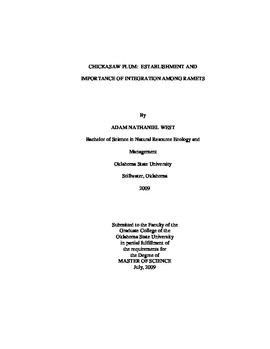| dc.description.abstract | I tested the effects of tillage, planting date, and competition control on the survival and growth of different propagule types (bare-root seedlings, coppiced transplants, and intact transplants) of Chickasaw plum (Prunus angustifolia), smooth sumac (Rhus glabra), and fragrant sumac (R. aromatica). In another experiment, I severed the roots between interconnected ramets on the interior and periphery of Chickasaw plum stands and left undisturbed control plots for comparison. Growth (diameter and height), net photosynthesis, stomatal conductance, intercellular COsub2; concentration, midday stem water potential, and soil volumetric water content of interconnected ramets were monitored to determine if ramets on one side of the severance were receiving carbon or water resource subsidy from ramets on the other side. In the first experiment, tillage did not affect survival or growth. After 2 years, plum seedlings had 50% higher survival than coppiced and intact transplants. Planting in late spring increased survival of plum coppiced transplants by 33%. Competition control with weed barrier cloth increased plum survival by 13% and diameter growth by 0.5 mm in the first year. For smooth sumac, there were no differences in survival and growth between CT and IT and survival was 49% after 2 years. For fragrant sumac, 83% of bare-root seedlings survived after 2 years. Overall, seedlings performed well, but if seedlings are not available, local transplants can be taken and planted at higher densities to achieve similar results. In the second experiment, severing had little or no effect on growth, photosynthesis, stomatal conductance, intercellular COsub2, stem water potential, and soil water. Though Chickasaw plum possesses persistent root connections between ramets there is minimal evidence of water or carbon resource integration between interconnected ramets under normal conditions. | |
